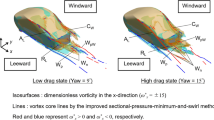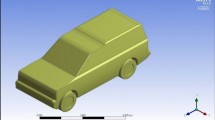Abstract
The paper describes flow control techniques viz. vane-type vortex generator (VG) array and rear-spoiler on its trunk (boot) side used to reduce drag of a passenger car. The experimental and computational studies were carried out and different cases and combinations were analyzed for the car model by varying incoming airflow angle and spoiler angle and orientations of VG array to find out the optimum conditions for which drag coefficient is found minimum. Shear stress transport (SST) k-w turbulence model is found suitable in predicting the multi-scale rear-wake vortices of the car geometry. It is found that the crossflow increases the drag coefficient, which can however be reduced effectively if both VG array and rear-spoiler are used. Parametric analysis shows that counter-rotating VG array is found useful in reducing drag (around 23 %) as it promotes better flow mixing at its downstream, which is helpful in avoiding flow separation. The finding is also supported by the flow visualization study. It is also found that saving up to 11.5 % in the fuel consumption can be achieved by reducing drag using these techniques. The wake analysis and turbulent kinetic energy plots indicated that the counterrotating VG array while used with a rear spoiler parallel to the flow reduced drag considerably.
Similar content being viewed by others
Abbreviations
- C D :
-
drag coefficient (dimensionless)
- C L :
-
centerline length of car (mm)
- C p :
-
wall static pressure coefficient (dimensionless)
- C μ :
-
turbulence model constant
- H :
-
height of car model (mm)
- k :
-
turbulent kinetic energy (m2s−2)
- L :
-
length of car model (mm)
- l :
-
length of rear spoiler (mm)
- p :
-
static pressure (Nm−2)
- Re :
-
reynolds number (dimensionless)
- u :
-
velocity (ms−1)
- W :
-
width of car model (mm)
- x, y, z :
-
coordinates
- α :
-
rear spoiler angle w.r.t. flow (degree)
- β :
-
car angle w.r.t. flow (degree)
- ε :
-
turbulent kinetic energy dissipation rate (m2s−3)
- ν :
-
kinematic viscosity coefficient (m2s−1)
- ω :
-
specific dissipation (s−1)
- i :
-
vector indices
References
Ahmed, S. R. (1981). Wake structure of typical automobile shapes. J. Fluids Engineering 103, 1, 162–169.
Ahmed, S. R., Ramm, G. and Faltin, G. (1984). Some salient features of the time-averaged ground vehicle wake. SAE Paper No. 840300.
Cakir, M. (2012). CFD Study on Aerodynamic Effects of a Rear Wing/Spoiler on a Passenger Vehicle. M. S. Thesis. Santa Clara University. Santa Clara, California, USA.
Chan, T. L., Gosse, K., Zhou, Y., Lee, S. C., Wang, X. W. and Huang, J. F. (2008b). Effect of rear slant angle on flow structures and pollutant dispersion in the wake of the studied model vehicle. Int. J. Heat and Mass Transfer 51, 25–26, 6180–6193.
Chan, T. L., Luo, D. D., Cheung, C. S. and Chan, C. K. (2008a). Large eddy simulation of flow structures and pollutant dispersion in the near-wake region of the studied ground vehicle for different driving conditions. Atmospheric Environment 42, 21, 5317–5339.
Cheng, S. Y. and Mansor, S. (2017). Rear-roof spoiler effect on the aerodynamic drag performance of a simplified hatchback model. J. Physics: Conf. Series 822, 1, 1–6.
Cho, J., Kim, T. K., Kim, K. H. and Yee, K. (2017). Comparative investigation on the aerodynamic effects of combined use of underbody drag reduction devices applied to real sedan. Int. J. Automotive Technology 18, 6, 959–971.
Desai, M., Channiwala, S. A. and Nagarseth, H. J. (2008). Experimental and computational aerodynamic investigations of a car. WSEAS Trans. Fluid Mechanics 4, 3, 359–368.
Geropp, D. and Odenthal, H. J. (2000). Drag reduction of motor vehicles by active flow control using the Coanda effects. Experiments in Fluids 28, 1, 74–85.
Gillhaus, A. and Hoffmann, R. (1998). Directional Stability. In: W. Hucho (Ed.) Aerodynamics of Road Vehicles. 4th edn. SAE International. Warrendale, Pennsylvania, USA, 239–310.
Guilmineau, E. (2008). Computational study of flow around a simplified car body. J. Wind Engineering and Industrial Aerodynamics 96, 6–7, 1207–1217.
Hanjalić, K. (1994). Advanced turbulence closure models: A view of current status and future prospects. Int. J. Heat and Fluid Flow 15, 3, 178–203.
Hassan, S. M. R., Islam, T., Ali, M. and Islam, M. Q. (2014). Numerical study on aerodynamic drag reduction of racing cars. Procedia Engineering, 90, 308–313.
Heft, A. I., Indinger, T. and Adams, N. A. (2012). Introduction of a new realistic generic car model for aerodynamics investigations. SAE Paper No. 2012-01-0168.
Heywood, J. B. (1989). Internal Combustion Engine Fundamentals. Int. edn. McGraw-Hill. Singapore.
Hucho, W. H. (1998). Aerodynamics of Road Vehicles. 4th edn. SAE International. Warrendale, Pennsylvania, USA.
Kang, S. O., Jun, S. O., Park, H. I., Song, K. S., Kee, J. D., Kim, K. H. and Lee, D. H. (2012). Actively translating a rear diffuser device for the aerodynamic drag reduction of passenger car. Int. J. Automotive Technology 13, 4, 583–592.
Katz, J. (1995). Race Car Aerodynamics: Designing for Speed. Bentley Publishers. Cambridge, USA.
Katz, J. (2006). Aerodynamics of race cars. Annual Review of Fluid Mechanics, 38, 27–63.
Kourta, A. and Gilliéron, P. (2009). Impact of the automotive aerodynamic control on the economic issues. J. Applied Fluid Mechanics 2, 2, 69–75.
Lin, J. C. (2002). Review of research on low-profile vortex generators to control boundary-layer separation. Progress in Aerospace Sciences 38, 4–5, 389–420.
Menter, F. (1994). Two-equation eddy-viscosity turbulence models for engineering applications. AIAA Journal 32, 8, 1598–1605.
Rouméas, M., Gilliéron, P. and Kourta, A. (2008). Drag reduction by flow separation control on a car after body. Int. J. Numerical Methods in Fluids 60, 11, 1222–1240.
Sagar, D. (2010). Aerodynamic Studies of Rear Spoilers and Vortex Generators on Passenger Car. M. S. Thesis. Motilal Nehru National Institute of Technology Allahabad. Prayagraj, India.
Schlichting, H. and Gersten, K. (2007). Boundary Layer Theory. 8th edn. Springer-Verlag Berlin Heidelberg. Heidelberg, Germany.
Song, K. S., Kang, S. O., Jun, S. O., Park, H. I., Kee, J. D., Kim, K. H. and Lee, D. H. (2012). Aerodynamic design optimization of rear body shapes of a sedan for drag reduction. Int. J. Automotive Technology 13, 6, 905–914.
Watkins, S. and Alam, F. (2012). Future vehicle thermal cooling and aerodynamic drag savings: Where will they come from?. Proc. Int. Conf. Advanced Vehicle Technologies and Integration (VTI2012 SS2006), Changchun, China, 75–782.
Author information
Authors and Affiliations
Corresponding author
Rights and permissions
About this article
Cite this article
Paul, A.R., Jain, A. & Alam, F. Drag Reduction of a Passenger Car Using Flow Control Techniques. Int.J Automot. Technol. 20, 397–410 (2019). https://doi.org/10.1007/s12239-019-0039-2
Received:
Revised:
Accepted:
Published:
Issue Date:
DOI: https://doi.org/10.1007/s12239-019-0039-2




